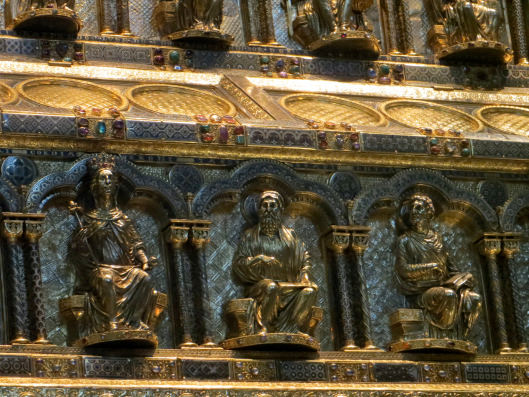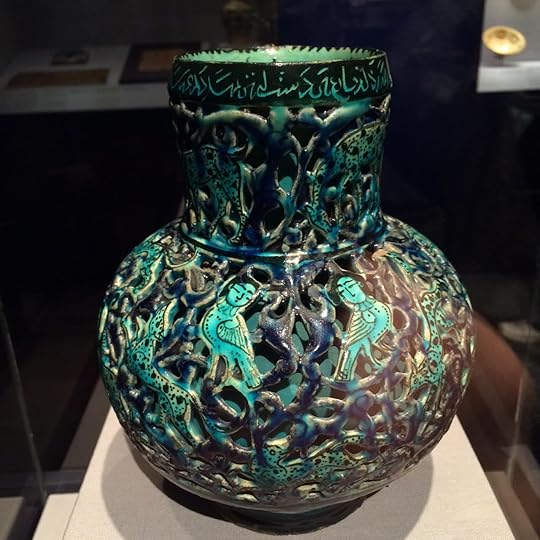Stephen Morris's Blog, page 37
July 29, 2016
Lammas Day, the beginning of Autumn 2016

Lammas bread loaves, fresh from the oven on my kitchen counter.
August 1 is Lammas Day (Anglo-Saxon hlaf-mas, “loaf-mass”), the festival of the wheat harvest, and was considered the first day of autumn in the traditional calendar of the pre-modern West (much as Labor Day is the beginning of autumn in the culture of the modern United States). On this day it was customary to bring to church a loaf made from the new crop, which began to be harvested at Lammastide. The loaf was blessed, and in Anglo-Saxon England it might be employed afterwards to work magic; a book of Anglo-Saxon charms directed that the Lammas Bread be broken into four bits, which were to be placed at the four corners of the barn, to protect the garnered grain. In many parts of England, tenants were bound to present freshly harvested wheat to their landlords on or before the first day of August. In the Anglo-Saxon Chronicle, where it is referred to regularly, it is called “the feast of first fruits”. (In Eastern Europe, the first honey of the season was brought to church to be blessed on August 1.)
As the wheat must have run low in the days before Lammas, and the new harvest began a season of plenty, of hard work and company in the fields, reaping in teams, [7] there was a spirit of celebratory play. In the medieval agricultural year, Lammas also marked the end of the hay harvest that had begun after Midsummer. At the end of hay-making a sheep would be loosed in the meadow among the mowers, for him to keep who could catch it.
In Shakespeare’s Romeo and Juliet (1.3.19) it is observed of Juliet, “Come Lammas Eve at night shall she [Juliet] be fourteen.” Since Juliet was born Lammas eve, she came before the harvest festival, which is significant since her life ended before she could reap what she had sown and enjoy the bounty of the harvest, in this case full consummation and enjoyment of her love with Romeo.
The post Lammas Day, the beginning of Autumn 2016 appeared first on Stephen Morris, author.
July 22, 2016
Christmas in July? (part 2)

Shrine of the Three Kings (detail), Nicholas of Verdun, gold, silver, and semi-precious stones (1190-1220), Cologne Cathedral, Cologne, Germany.
The Magi were extremely popular in Western Europe during the Middle Ages and Renaissance. They were considered powerful protectors against the “falling sickness” (epilepsy). They were also invoked in all-purpose protective prayers or charms, such as one attributed to Charlemagne.
The Magi were considered to represent the whole of the Gentile world because the three men included an Asian and an African with the European; they underscored the idealized inclusivity of the Christian world. The African magus — and African Christians in Ethiopia, such as the eunuch baptized by the Apostle Phillip in the Acts of the Apostles (8:27) — were looked on as special patrons of the people of Bohemia since both Bohemia and Ethiopia were on the edges of the (western) Christian world. The city of Kandahar in Afghanistan is thought to have been founded by and named for Gaspar, one of the Magi.
The relics of the Magi at Cologne were among the most popular pilgrimage sites in the Middle Ages. Their presence helped bolster the importance of the Germanic bishops both as supporters of the Popes or in opposition to them.
More information about the Magi in the Middle Ages can be found here and here.
The excellent Journey of the Magi by Richard Trexler might by a good thing to read in anticipation of Christmas. Better to read it NOW, before the hectic pre-holiday season arrives!
The post Christmas in July? (part 2) appeared first on Stephen Morris, author.
July 15, 2016
Christmas in July?

Shrine of the Three Magi, Cologne cathedral, Germany

Shrine of the Three Magi, Cologne cathedral, Germany
(another view).
Although the Magi are most often associated with Christmas and Epiphany on December 25 and January 6 each year, they are also associated with July 23, the day their bodies (relics) arrived in Cologne, Germany in 1164.
The relics of the Magi were taken from Milan by Holy Roman Emperor Fredrick Barbarossa and given to the Archbishop of Cologne, Rainald of Dassel in 1164. The Three Kings have since attracted a constant stream of pilgrims to Cologne. Parts of the shrine were designed by the famous medieval goldsmith Nicholas of Verdun, who began work on it in 1180 or 1181. It has elaborate gold sculptures of the prophets and apostles, and scenes from the life of Christ. The shrine was completed circa 1225.
Around 1199, King Otto gave three golden crowns made for the three wise men as a present to the church of Cologne. Because of the importance of the shrine and the cathedral for the later development of the city, the Coat of Arms of Cologne still shows these three crowns symbolizing the Three Kings.
Construction of the present Cologne Cathedral was begun in 1248 to house these important relics. The cathedral took 632 years to complete and is now the largest Gothic church in northern Europe.
Map of Bones, a great sci-fi thriller by James Rollins, begins with the celebration of the bones of the Magi in the Cologne cathedral.
A mystery, “The Bishop and the Three Kings” by Andrew Greeley, is about the theft of the shrine.
Read more about the shrine of the Magi in Cologne here.
The post Christmas in July? appeared first on Stephen Morris, author.
July 8, 2016
Veronica and the Shroud

Veronica holding her veil, by Hans Memling (c. 1470)
According to legend, a woman named Veronica (who is commemorated on July 12) was among the crowds lining the streets of Jerusalem as Jesus carried the cross on his way to be crucified on Golgotha. Feeling pity for him, she stepped forward and wiped the sweat and blood from his face with her veil. Later that evening, she is said to have discovered the image of Christ’s face imprinted on her veil.
Many people think this story is a variation on the story of the Shroud of Turin, said to be the shroud in which Jesus was buried. It was also said to have been imprinted with the image of Jesus’ body in the moment just before his Resurrection. Because of the way the Shroud was traditionally folded when put on display, only the face was visible. This resulted in an image much like the one reputed to have been imprinted on Veronica’s veil. Many also point out that the woman’s name, “Veronica,” is in fact Latin for “true image” or “true/authentic icon” and is more a statement about the cloth than about her historical identity.
The story of the Icon-Made-Without-Hands is also about a Byzantine cloth on which Jesus himself imprinted his face to send to the king of Edessa so that the ailing king might be healed. Again, this “true icon” is said by many to be another version of the same story and that all 3 versions are probably based on the historical kernel that there was indeed a cloth image of Jesus that was venerated by the Church during its early centuries as an authentic, miraculous reproduction of Christ that was thought to work miracles.
This textile image plays an important role in two books that I highly recommend:
The Fifth Gospel by Ian Caldwell is a thriller set in the Vatican in which a long-lost gospel text, a contentious relic [i.e. the Shroud of Turin], and a dying pope’s final wish converge to send two brothers—both Vatican priests—on an intellectual quest to untangle Christianity’s greatest historical mystery.
Death Masks by Jim Butcher is one of his EXCELLENT Harry Dresden series in which Harry, Chicago’s only practising professional wizard, is caught in a duel with the Red Court of Vampires’ champion, who must kill Harry to end the war between vampires and wizards …Professional hit men using Harry for target practice …The missing Shroud of Turin …A handless and headless corpse the Chicago police need identified …
Both are excellent summertime reading — especially in connection with July 12, the feast of Veronica and her veil!
The post Veronica and the Shroud appeared first on Stephen Morris, author.
July 1, 2016
Dancing Plague

Dorothy’s ruby slippers are the most famous red shoes in history.
In the searing July heat of 1518, Frau Troffea stepped into the streets of Strasbourg and began to dance. Bathed in sweat, she continued to dance. Overcome with exhaustion, she stopped, and then resumed her solitary jig a few hours later. Over the next two months, roughly four hundred people succumbed to the same agonizing compulsion. At its peak, the epidemic claimed the lives of fifteen men, women, and children a day. Possibly 100 people danced to their deaths in one of the most bizarre and terrifying plagues in history.
Eventually, 2 cures were found for the plague: making an offering at a local shrine to St. Vitus, long thought the patron of those afflicted with “St. Vitus’ Dance” (epilepsy), or wearing red shoes. Or donating a pair of red shoes to the shrine. Although many pairs of magical footwear appear in fairy tales (the seven-league boots, the silver slippers in Baum’s original Wonderful Wizard of Oz, the slippers Cinderella wore to the ball, the slippers of bread dough a wealthy Czech woman wore to her damnation), the red shoes have both healed uncontrollable dancing and damned their owner to uncontrollable dancing (as in Anderson’s story of the Red Shoes).
Red was an especially expensive dye to obtain or use; red clothes were the prerogative of the wealthy and the ostentatious. Red (associated with blood, fire, life, and sex) is also used to mark those who misbehave sexually as well as the saints (“washed in the blood of the Lamb”). In Slavic languages, the same word can mean both “red” and “beautiful” so instead of calling it “Red Square” outside the Kremlin, a better translation might be “Beautiful Square.”
TO read Elizabeth King’s fascinating essay about magical shoes in fairy tales, click here.
TO read more about the fascinating Dancing Plague, click here and here.
The post Dancing Plague appeared first on Stephen Morris, author.
June 24, 2016
Interviewed by Don Massenzio
 Don Massenzio writes crime stories and thrillers. He has a very popular blog, which you can find here. He frequently invites other writers to make guest posts on his blog. He also interviews other authors and posts the transcripts of the interviews on his blog. He has an interview with ME that he will be posting on Friday, June 24.
Don Massenzio writes crime stories and thrillers. He has a very popular blog, which you can find here. He frequently invites other writers to make guest posts on his blog. He also interviews other authors and posts the transcripts of the interviews on his blog. He has an interview with ME that he will be posting on Friday, June 24. 
June 17, 2016
Vidovdan

St. Vitus’ Day (Vidovdan) marks the Ottoman defeat of the Serbians at Kosovo in 1389.
St. Vitus, a Christian in Sicily who was killed for his faith in A.D. 303, is commemorated each year in mid-June. He is most often associated with epileptics or those who have seizures for other reasons, because he looked as if he was having a seizure as a lion killed him and tore his body to shreds. He is also said to protect against lightning strikes, animal attacks and oversleeping. He is the patron of the cathedral in Prague.
He is also important in the history of Serbia. It was on his feast day (known as “Vidovdan” in Serbian) that the Serbian army, led by Prince Lazar, was defeated by the Ottoman army led by Sultan Murad in the field of Kosovo. The defeat at Kosovo on Vidovdan came to be considered the defining moment of Serbian national consciousness as it was the first time that several of the Serbian clans set aside their local disputes and came together for a common purpose (under the leadership of Prince Lazar). The anniversary of the defeat at Kosovo is particularly important to Serbian history, tradition, and national identity. The date is ingrained in the Serb consciousness, and is the date on which South Slav nationalist Gavrilo Princip assassinated Archduke Franz Ferdinand, setting off a chain of events that led to the outbreak of World War I.
Reliable historical accounts of the battle are scarce. The bulk of both armies were wiped out in the battle; both Lazar and Murad lost their lives in it. Although Ottomans managed to annihilate the Serbian army, they also suffered high casualties which delayed their progress. Serbs were left with too few men to effectively defend their lands, while the Turks had many more troops in the east. Consequently, one after the other, the Serbian principalities that were not already Ottoman vassals became so in the following years.
One of my best friends in seminary, a third generation Serbian-American, said once, “Only the Serbians would make a national holiday out of their worst-ever military defeat!”
The post Vidovdan appeared first on Stephen Morris, author.
June 10, 2016
Stars and Cards: Gemini

The Lovers and the Magician from the Tarot of Marseille deck, published by Lo Scarabeo.
The sun begins its month-long journey through Gemini, the sign of the zodiac associated with the Lovers trump of the tarot, on May 21. The sign Gemini belongs to the element air and is ruled by the planet Mercury (the Greek messenger of the gods), which is linked to the Magician trump of the tarot. The tarot’s air suit of swords illustrates typical scenes of daily life related to intellect, communication, logic, strife, conflict, choice, decision-making and the overcoming of adversity.
As an air sign, Gemini is concerned with all aspects of the mind. This zodiac sign is ruled by Mercury, which is a planet that represents communication, writing and teaching others. They get fascinated by almost everything in the world and they have a feeling as if there is not enough time to experience everything they want to see. This makes them excellent artists, writers and journalists. Gemini sign means that sometimes people born under this sign have a feeling that their other half is missing, so they are forever seeking for new friends, mentors and colleagues.
During the time of the sign Gemini, we have an excellent opportunity to meditate on the tarot’s Lovers and Magician cards, as well as the suit of swords of the minor arcana. Ponder the myths of Castor and Pollux, and of Helen of Troy — all figures associated with the constellation Gemini. Do you show your loved one how much you really care? What are the important decisions you are facing in your life and what are the potential consequences? Where must you turn away from the things of childhood and assume your position as an adult member of society? How can you use your talents to work magic in your own life and in the lives of those around you?
The post Stars and Cards: Gemini appeared first on Stephen Morris, author.
June 3, 2016
May Wine

Woodruff is associated with the planet Mars and the element of Fire.
Even if it is a few days past the end of May, there is still time to enjoy a glass or two of May wine!
May wine, a popular spring-time beverage in Germany or German-speaking areas, is made by steeping sweet woodruff in white wine. Sweet woodruff has a strong scent, which increases when the woodruff wilts. The fragrance persists as the woodruff dries, and the dried plant is used in potpourri and as a moth deterrent. Dried woodruff is also used, mainly in Germany, to flavor May wine, sweet juice punch, syrup for beer (Berliner Weisse), brandy, jelly, jam, a soft drink (Tarhun, which is Georgian), ice cream, and herbal tea. Also very popular are Waldmeister flavored jellies, with and without alcohol. In Germany it is also used to flavor sherbet powder, which features prominently in Günter Grass’s novel The Tin Drum.
Woodruff is carried by business-folk to attract wealth and prosperity or by soldiers and athletes to attract victory. Anyone who carries a bit of woodruff in a leather sachet is protected against harm, especially harmful magic or ill wishes. In astrology, Mars is the planet of energy, action, and desire. It is the survival instinct, and can be thought of as the “leftover” animal nature of man. It is this association with the planet Mars that causes woodruff to drive its bearer to success and victory and fights against the harmful magic directed against its bearer (leather being associated with soldiers’ protective “armor” in the ancient or medieval world since metal protective gear — i.e. a knight’s suit of armor — was too expensive for most peasant soldiers).
Maybe a glass or two of May Wine is just what I need to get rich or win the Olympics? Or protect myself against witchcraft and black magic? I should definitely enjoy some May Wine before selecting the numbers the next time I buy a lotto ticket!
The post May Wine appeared first on Stephen Morris, author.
May 27, 2016
Black Monday, 1453

Hagia Sophia, the great cathedral of Holy Wisdom, was built by the emperor Justinian and was the largest dome in the world until the Astrodome was built. The minarets were added by the Turks when they converted the cathedral into a mosque after they captured the city in 1453.
May 29, 1453. It was a Monday and lived on as “Black Monday” in Orthodox territory because that was the day that the great city of Constantinople fell to the Turks. Byzantium came crashing to a halt and the Ottoman Empire arose from its ashes, ruling much of the Middle East as well as portions of Central and Eastern Europe until it ceased to exit in 1923.
The conquest of Constantinople reinforced Byzantine expectations that the world was about to end. Byzantine churchmen calculated that the world would be 7,000 years old on September 1, 1492 and would therefore end on that day. They thought the Turks were the forerunners of the Antichrist and the Turkish conquest of New Rome, the official title of the city, the beginning of the last period of world history.
The art of the Seljuq Turks is currently on display at the Metropolitan Museum of Art, through July 24. Among the treasures displayed there are the harpy pitcher (see below). Harpies, birds with the heads of human women, are an image the Turks inherited from the classical Greeks. The Turks associated harpies with the astrological sign of Gemini and brought happiness in their wake. They were considered protective creatures. Spotting one was a good omen. This is all in marked contrast with the classical perception of harpies as wicked, dangerous creatures who delighted in abducting and torturing their victims.
The post Black Monday, 1453 appeared first on Stephen Morris, author.





